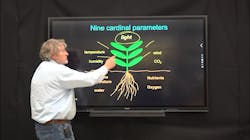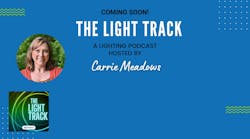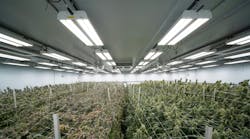As LEDs Magazine has reported in its event preview coverage, the annual HortiCann Light + Tech conference is being held virtually this year due to the ongoing coronavirus pandemic. Despite the challenges of the global health crisis, stakeholders across the grower and agricultural sectors to utility and consultancy representatives to LED technology and solid-state lighting (SSL) manufacturers gathered online to benefit from the sharing of advances in science and metrics/standards, case studies, and strategies for integrating horticultural SSL and multiple AgTech systems.
Day 1 opened with a highly technical keynote by crop physiology professor Bruce Bugbee of Utah State University. Bugbee’s main mission was to inform the audience on past scientific data interpretations that were used to deliver standards and metrics for how plants utilize photons, then how new studies show that far-red (700‒750 nm) photons generate specific responses in plants that might be considered relevant for future revision of the metrics. Scientists, product developers, and end-product operators can put that information to use in horticultural lighting and associated systems for controlled environment agriculture (CEA).
During a sponsored presentation from Osram Opto Semiconductors, director of product management Renil Singh echoed the red refrain with his talk “Red reigns supreme: Maximizing system photon efficacy of broad-spectrum horticulture lighting.” Singh established that LEDs with longer wavelengths (660 nm) contain more photons than LEDs with shorter wavelengths (450 nm) at equal radiant power. This detail can help in customizing light mixes, or recipes, to encourage desirable cultivar features in leafy crops such as lettuces and kales because red photons help to expand cell production, thereby enabling leaves to grow larger, for example.
“Characterizing light for plant response” was Session 1 of the program, and the individual speakers further discussed metrics and test methodologies for developing SSL products suitable for plants and minimize energy waste. SunTracker Technologies scientist Ian Ashdown weighed in on the idea of the red-to-far-red ratio (R:FR) initially explained during the Keynote, and observed that plants also respond to a type of circadian rhythm known as photoperiodism. When plants react to the higher R:FR ratio at sunrise and sunset, he posited, does this mean that scientists may discover that emulating the photon mix of sunrise and sunset cycles through controlled and tuned LED lighting could result in healthier plants?
DesignLights Consortium (DLC) senior lighting scientist Leora Radetsky then took the floor to explain the DLC’s methodology in developing criteria for its Horticultural Lighting Technical Requirements that are under investigation for Version 2.1. As DLC is still accepting comments on the proposed draft changes, Radetsky noted that industry participation is imperative to ensure that the optimal information is used to create such guidelines for its Qualified Products List (QPL).
The final speaker in the session, consultant Eric Bretschneider, explained the missing link for product developers and their customers in what is considered industry standard performance reporting. He said that spectral quantum distribution (SQD) files contain significant data that is needed by customers to make informed decisions on products that will yield the desired results in a horticultural operation. The full session theme brought home the point that there is no one clear-cut way to apply horticultural SSL; the science continues to evolve and inform new standards, guidelines, and performance test methodologies – which also need to be applied with consideration to the demands of individual cultivars.
Last, a cross-disciplinary panel dove into the theme of integration and getting all project team members — from facilities architecture and construction personnel to the lighting provider and installer to controls and HVAC management supplier — on the same wavelength to deliver an optimal ecosystem with intelligent and sometimes automated functionality for the grower. These are not your typical, everyday farms. These are controlled environments on the level of what you’d see in electronics manufacturing & assembly – only they are growing food sources and legalized cannabis in a highly complex and informed operation.
Panel leader Derek Smith of Resource Innovation Institute spoke about resource benchmarking and understanding the appropriate levels of water, energy, and waste management that will help grower facilities meet or exceed sustainability goals and their bottom lines. Architect Brian Anderson (Anderson Porter Design) showed an example plan that encompassed all the facility goals from employee workflow to the dimensions of the canopy area, and much more. TSRgrow president Mikhail Sagal proceeded to establish how lighting can be a powerful hub in the facility design, with integration of lighting hardware, lighting controls, and other systems that control water, plant nutrient delivery, and environmental conditions. He specifically noted that the closed-loop system design would enable sophisticated data collection, analytics, and action capability for improved crop management. Finally, Desert Aire president Keith Coursin discussed the role of HVAC and dehumidification functions that are constantly affected by the conditions of the growing plants. Understanding their role in the indoor conditions requires elegant solutions, said Coursin, to manage and maintain the right levels of temperature, humidity, CO2, which are constantly fluctuating.
As outlined in our previously-linked preview article, integration and collaboration are the new drivers for success in the horticultural and AgTech space. We look forward to the Day 2 presentations tomorrow, Oct. 21. You can join us live or register and view sessions on demand until January 21, 2021.
For up-to-the-minute LED and SSL updates, why not follow us on Twitter? You’ll find curated content and commentary, as well as information on industry events, webcasts, and surveys on our LinkedIn Company Page and our Facebook page.






